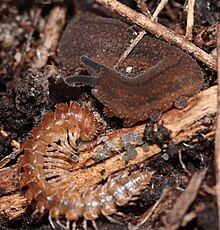| Panarthropoda | |
|---|---|

| |
| Panarthropods include onychophorans such as Peripatopsis and arthropods such as polydesmid millipedes | |
| Scientific classification | |
| Domain: | Eukaryota |
| Kingdom: | Animalia |
| Clade: | ParaHoxozoa |
| Clade: | Bilateria |
| Clade: | Nephrozoa |
| (unranked): | Protostomia |
| Superphylum: | Ecdysozoa |
| (unranked): | Panarthropoda Nielsen, 1995 |
| Phyla | |
Panarthropoda is a proposed animal clade containing the extant phyla Arthropoda, Tardigrada (water bears) and Onychophora (velvet worms).[3] Panarthropods also include extinct marine legged worms known as lobopodians ("Lobopodia"), a paraphyletic group where the last common ancestor and basal members (stem-group) of each extant panarthropod phylum are thought to have risen.[4][5][6][7][8][9] However the term "Lobopodia" is sometimes expanded to include tardigrades and onychophorans as well.[5]
Common characteristics of the Panarthropoda include a segmented body, paired ladder-like ventral nervous system, and the presence of paired appendages correlated with body segments.[10][5][6][8]
- ^ Rota-Stabelli, Omar; Daley, Allison C.; Pisani, Davide (March 2013). "Molecular Timetrees Reveal a Cambrian Colonization of Land and a New Scenario for Ecdysozoan Evolution". Current Biology. 23 (5): 392–398. Bibcode:2013CBio...23..392R. doi:10.1016/j.cub.2013.01.026. PMID 23375891.
- ^ Chen, Zhe; Chen, Xiang; Zhou, Chuanming; Yuan, Xunlai; Xiao, Shuhai (6 June 2018). "Late Ediacaran trackways produced by bilaterian animals with paired appendages". Science Advances. 4 (6): eaao6691. Bibcode:2018SciA....4.6691C. doi:10.1126/sciadv.aao6691. hdl:10919/84444. PMC 5990303. PMID 29881773.
- ^ Cite error: The named reference
Telford2008was invoked but never defined (see the help page). - ^ Cite error: The named reference
:0was invoked but never defined (see the help page). - ^ a b c Cite error: The named reference
OrtegaHernandez2016was invoked but never defined (see the help page). - ^ a b Ortega-Hernández, Javier; Janssen, Ralf; Budd, Graham E. (2017-05-01). "Origin and evolution of the panarthropod head – A palaeobiological and developmental perspective". Arthropod Structure & Development. Evolution of Segmentation. 46 (3): 354–379. Bibcode:2017ArtSD..46..354O. doi:10.1016/j.asd.2016.10.011. ISSN 1467-8039. PMID 27989966.
- ^ Giribet, Gonzalo; Edgecombe, Gregory D. (2019-06-17). "The Phylogeny and Evolutionary History of Arthropods". Current Biology. 29 (12): R592–R602. Bibcode:2019CBio...29.R592G. doi:10.1016/j.cub.2019.04.057. ISSN 0960-9822. PMID 31211983. S2CID 189926344.
- ^ a b Chipman, Ariel D.; Edgecombe, Gregory D. (2019-10-09). "Developing an integrated understanding of the evolution of arthropod segmentation using fossils and evo-devo". Proceedings of the Royal Society B: Biological Sciences. 286 (1912): 20191881. doi:10.1098/rspb.2019.1881. ISSN 0962-8452. PMC 6790758. PMID 31575373.
- ^ Edgecombe, Gregory D. (2020-11-02). "Arthropod origins: Integrating paleontological and molecular evidence". Annual Review of Ecology, Evolution, and Systematics. 51 (1): 1–25. doi:10.1146/annurev-ecolsys-011720-124437. ISSN 1543-592X. S2CID 225478171.
- ^ Cite error: The named reference
:1was invoked but never defined (see the help page).